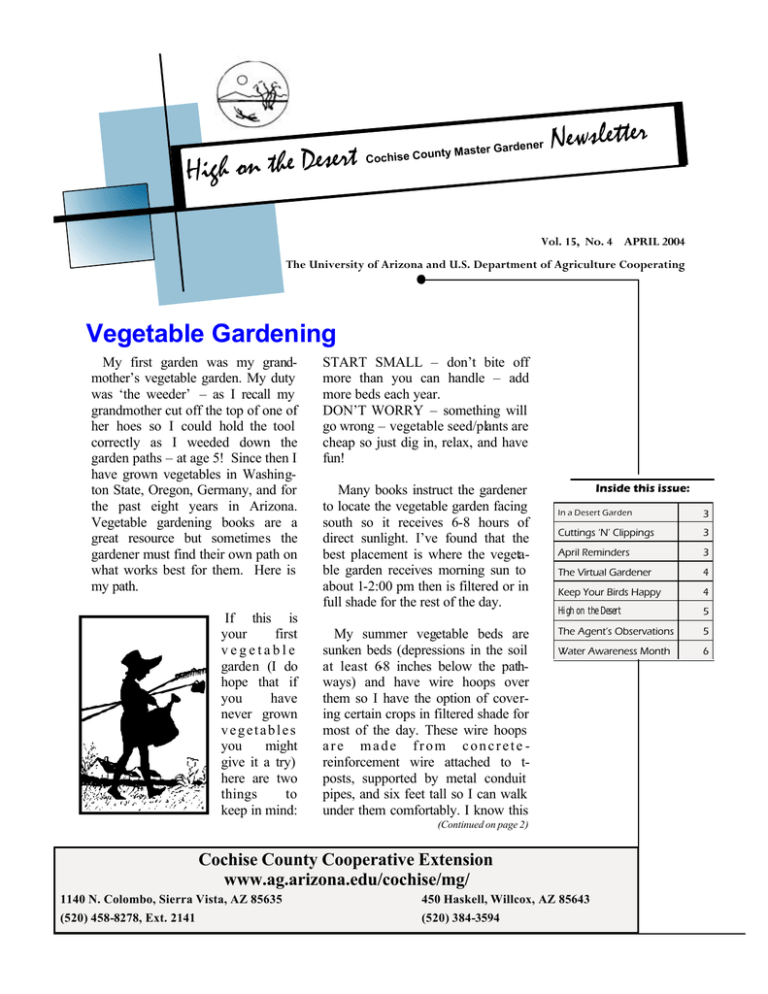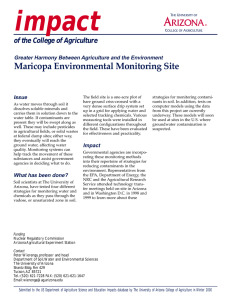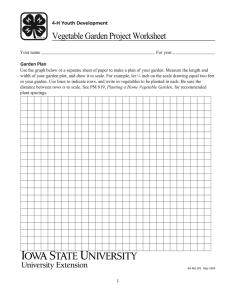Newsletter High on the Desert
advertisement

High on the Desert r Cochise r Gardene County Maste Newsletter Vol. 15, No. 4 APRIL 2004 The University of Arizona and U.S. Department of Agriculture Cooperating Vegetable Gardening My first garden was my grandmother’s vegetable garden. My duty was ‘the weeder’ – as I recall my grandmother cut off the top of one of her hoes so I could hold the tool correctly as I weeded down the garden paths – at age 5! Since then I have grown vegetables in Washington State, Oregon, Germany, and for the past eight years in Arizona. Vegetable gardening books are a great resource but sometimes the gardener must find their own path on what works best for them. Here is my path. If this is your first vegetable garden (I do hope that if you have never grown vegetables you might give it a try) here are two things to keep in mind: START SMALL – don’t bite off more than you can handle – add more beds each year. DON’T WORRY – something will go wrong – vegetable seed/plants are cheap so just dig in, relax, and have fun! Many books instruct the gardener to locate the vegetable garden facing south so it receives 6-8 hours of direct sunlight. I’ve found that the best placement is where the vegetable garden receives morning sun to about 1-2:00 pm then is filtered or in full shade for the rest of the day. My summer vegetable beds are sunken beds (depressions in the soil at least 6-8 inches below the pathways) and have wire hoops over them so I have the option of covering certain crops in filtered shade for most of the day. These wire hoops are made from concrete reinforcement wire attached to tposts, supported by metal conduit pipes, and six feet tall so I can walk under them comfortably. I know this Inside this issue: In a Desert Garden 3 Cuttings ‘N’ Clippings 3 April Reminders 3 The Virtual Gardener 4 Keep Your Birds Happy 4 High on the Desert 5 The Agent’s Observations 5 Water Awareness Month 6 (Continued on page 2) Cochise County Cooperative Extension www.ag.arizona.edu/cochise/mg/ 1140 N. Colombo, Sierra Vista, AZ 85635 450 Haskell, Willcox, AZ 85643 (520) 458-8278, Ext. 2141 (520) 384-3594 PAGE 2 (Continued from page 1) set-up sounds complicated but it’s not. This set-up can also double as a greenhouse when covered with plastic. The beds are 10 feet wide by 20 feet long. My cool season beds are woodframed raised beds with plastic hoops over them and clear plastic attached to it. The raised bed exposes the soil (which keeps the soil warmer than the sunken beds) and I find I get better germination, the plants are healthy, and the salad greens stay cleaner so I never have to wash them. The beds can be covered with blankets during nights that freeze. In addition these raised beds double as cold or hot frames for raising or hardening off seedlings. The beds are five feet wide by ten feet long, with two center dividers, the pine wood is 2 inches thick by 12 inches deep and the bottoms have ¼ inch wire hardware mesh attached to them to keep the gophers out. My garden plan consists of two raised beds, two ‘soil level’ herb beds, two double raised herb beds, four asparagus beds, two raspberry beds and four sunken beds. All but the perennial beds are rotated each year to reduce any soil or pest problems. Whether you are starting a new garden or have an existing one this is a good time to build the soil. Often the terms ‘Soil Improvements’ and ‘Mulches’ can cause confusion because the same materials can be used for both but they serve different functions. Soil Improvements is an organic material that is incorporated into the soil. When it comes to what type of material to add to soils, I think there is nothing better than good ole’ compost. Compost is decayed plants, kitchen waste, and farm animal manure. It adds nutrients and organic matter to the soil and stimulates soil microorganisms. Compost can improve drainage in tight, clay soils, and increase water retention in sandy soils. Finished compost should be dark, crumbly, and smell great – like the earth. I didn’t have any compost made by the time I planted my first veggie crop so I planted straight into the unimproved soil and got a great crop. I had compost ready the second season and started building the soil and each year I add as much compost as I can make. Mulch is a layer of organic materials that cover the top of the soil around the root zones of plants. Its duty is to conserve water, inhibit weeds, and modify soil temperatures. For the vegetable garden I use two types of mulches – alfalfa hay and cover crops. I buy bales of alfalfa hay at the local feed store and spread it around the garden, including the paths. I lay down a thin layer of hay – about an inch – and put down soaker hoses on top of that. As the veggies grow taller I keep adding hay until it reaches a depth of 46 inches (the hay will eventual compact down into a nice dense layer). Cover crops are a green manure that acts as a living mulch AND when incorporated into the soil becomes a soil improvement – double bang for the buck! Some cover crops are legumes and add nitrogen to the soil. I often plant beans and peas as it acts as cover crop AND gives me a food supply. I like to plant buckwheat as a living mulch with the corn, melons, and beans. I plant annual rye grass or wheat in the plots that are left fallow over the winter months and about four weeks before planting time I incorporate the cover crops into the soil so they will break down and become a natural fertilizer – please remember that WHEN YOU FEED THE SOIL -- THE SOIL WILL FEED THE PLANT. For some more info on growing veggies and soil building check out these sources: Extreme Gardening , Dave Owens ISBN 0-9705016-0-9 Gaia’s Garden: A Guide to Home -Scale Permaculture, Toby Hemenway, ISBN 1890132-52-7 Great Garden Companions, Sally Jean Cunningham ISBN 087596-847-3 The Sustainable Vegetable Garden, John Jeavons and Carol Cox, ISBN 1-58008-016-2 University of Arizona Cooperative Extension – Master Gardener Manual – Vegetable Gardening http://ag.arizona. edu/pubs/garden/mg/vegetable/ index.html NEXT TIME: What shall we grow? Cheri Melton, Master Gardener April Reminders ? ? ? ? ? Stake new trees Plant cool-season veggies Fertilize Plant cool-season veggies Prepare for pests PAGE 3 In a Desert Garden Tithonia – Mexican Sunflower The first time I laid eyes on this beauty was in late spring in my garden. At first there was nothing but some velvety leaves in the gravel. I thought it was a weed and almost pulled it, but over the years I have learned not to do that. I only pull a plant when I can identify it for sure. The birds have brought me the most delightful desert plants and I am always grateful when something shows up I do not have to fuss over. That thing grew and grew, right in the center of an arbor with a rose. Well, it grew to about 4 feet in height and three feet in width. Then one morning, the first flowers unfolded. How beautiful! They were daisy-like bright orange flowers and the butterflies just loved them. It flowered all rainy season long with an abundant of flowers. When the dry season came it shriveled up and died but it left its mark. Every year several of these beautiful plants appear. Of course they are never as centered and amazing as the first one but I love them all. Why don’t you try this plant, just throw a few seeds. Plant profile: Native from Mexico to Central America, can grow to 6 feet tall and 4 feet wide, velvety green leaves, spectacular orange or yellow flowers, tolerates poor soil and some draught. Attractive to Butterflies and Hummingbirds. Annual, self seeds. Angel Rutherford, Master Gardener Cuttings ‘N’ Clippings T Cochise County Master Gardeners Association (CCMGA) next meeting will be April 1 at 5:00 at the UAS Campus, Room 106. April is Water Awareness Month! T The April 3 Water Wise workshop The Basics of Drip Irrigation (learn about the components of a drip system and how to put together a simple system) will be presented by Penny Artio, UAS Grounds Supervisor, 9:00— 11:00 a.m. at the University of Arizona South (1140 N. Colombo). This workshop is free and open to the public. For a complete list of workshops go to www.ag.arizona. edu/cochise/waterwise/ events.htm or contact Cado Daily at the Cooperative Extension, Ext. 2139. T On April 10 a Hands-on Water harvesting Workshop will be held, 9:00—noon at the University of Arizona South. You will make your own contour level, learn how to contour and make berms and swales. Jim Riggs, Master Watershed Steward Program and Cado Daily, Water Wise Program, will teach the class. There is a small fee for level materials and registration is required. (458-8278, X 2141) T Saturday, April 17, 11:00 – noon learn how you can have a beautiful water wise landscape with Cado Daily. Topics include plant selection, watering, and designs. Call Cochise College to register at 515-5492. T Saturday, April 24, Angel Rutherford and Joan Wakefield tell all their secrets of maintaining a healthy environment for plants and critters in Pond Ecology, manage algae, make your plants and fish thrive lecture and slide show at Cochise College from 9:30— 11:30 a.m. For information and reservations call 515-5492. T May 1 Water Wise workshop is When Do I Water? with Rob Call, Extension Agent, 8:30—9:30 a.m. at the University of Arizona South followed by the Spring Xeriscape Tour. Maps will be available midApril from the Sierra Vista Cooperative Extension Office (458-8278 Ext. 2141). T May 1 is also the grand opening and celebration of spring at the Bisbee Farmers Market 8:00 a.m.– noon at Vista Park, Bisbee. For information contact Valerie McCaffrey at 432-7066 or e-mail: vallimac@ivwnet.com Robert E. Call Extension Agent, Horticulture Carolyn Gruenhagen Editor PAGE 4 The Virtual Gardener—Balance in Landscape Design In the physical world imbalance may lead to collapse. To our brains imbalance shouts, “Danger!” This effect also extends to the visual world. Perhaps that’s why one of the principles of landscape design is achieving balance. We grasp the idea of physical balance intuitively. Think of an old-fashioned scale. We expect that the scale will be balanced when objects of identical weight are placed on opposite ends of the scale. This is an example of symmetric balance—two identical objects placed at equal distances from a balance point. We can achieve balance asymmetrically by placing several smaller objects on one side of the scale so that their total weight equals the weight of the larger object. Or we can asymmetrically balance a larger object by placing a smaller object at a greater distance from the balance point. The greater the difference in weight between the two objects, the farther the smaller object needs to be placed from the balance point to maintain the balance. The same principles apply to achieving balance in a landscape. In the case of the landscape the balance point is a focal point, and the objects being balanced are landscape elements such as plants or hardscape features. The visual “mass” or “weight” of landscape elements are determined by their size and form, texture, and color. We can achieve visual symmetrical balance in a landscape when we place identical features at equal distances on either side of a focal point. For example two identical shrubs at equal distances on either side of an entryway have symmetric balance. Symmetrical designs are easy to visualize, but difficult to maintain with plants in a landscape since plants don’t always grow to perfectly matched shapes and even small deviations from symmetry can spoil the effect. This means a lot of pruning to keep the balance. Asymmetric balance in the landscape is often more difficult to design for, but once achieved is easier to maintain. The same principles apply as for physical balance except we use visual weight rather than physical weight to achieve the effect. Visual weight is expressed as the sum of size (bigger is heavier), texture (coarse is heavier than fine), dens ity (dense is heavier), and color (dark colors are heavier than light ones). Let your eye be the judge. Next time you add to your landscape, be aware of the need for visual balance and look for opportunities to apply the princ iples of balanced design. To find out more about this topic, point your browser at http://www. gardengatemagazine.com/design/ ggbal.html. Until next time, Happy Surfing. Gary A. Gruenhagen, Master Gardener gruenha@sinosa.com How to Keep Your Birds Happy!!! Spring: To help birds build a cozy nest, drape short lengths of string over shrubs and scatter white feathers, dog combings, and other soft materials. Summer: Replace your bird feeders with suet. Nestlings love the softer food. -Backyard Birdwatcher High on the Desert T-shirts available at the Sierra Vista Cooperative Extension Office. PAGE 5 High on the Desert Our 11th Annual High Desert Gardening & Landscaping Conference has come and gone. From all reports everyone had a great time and learned so much. The new venue at Buena High School received mostly favorable comments. It is with great pleasure that we say, “Thanks! Job well done!” to all the dedicated volunteers of the Cochise County Master Gardeners Association! Special thanks to our sponsors: Bella Vista Ranches Desert Trees Nursery, Tucson. Door Prize Donors Special thanks to Ace Garden Place, Mountain States Wholesale Nursery, Southwest Desert Images, and Southwest Native Habitat Design for their generous donations of plants Speakers: A great big THANK YOU! We couldn’t have done it without you! Committee chairpersons and CCMGA Membe rs who gave so much of their time, energy, and talents to make it all work: Thanks also to the following: Rob Call, Extension Agent, Conference Coordinator and Program Advertisers: Program Chair, Penny Artio, ACE Garden Place, Bloom Coun- Publicity, Emily Boyd, Cado try, Butterfly Gardens, Inc., Castro Daily, Deke & Peggy Descoteaux, Electric, Castle & Cooke, Desert Carolyn Gruenhagen, Gary Trees, Gardening in Water, Joan Gruenhagen, Registration Chair, Wakefield, Kanmar Gutters, Anne Hughes, Joyce Gay, TreasMountain View Koi Fish, Ramsey urer, Diane Levine, De Lewis, Canyon Feed & Pet, Southwest Charlie Narburgh, Facilities Native Habitat Design, The Chair, Angel Rutherford, Robin Bindery, Whetstone Southwest Storey, Joan Wakefield, Pat Pottery & Fountains, and Wild Walton, and the Cooperative Birds Unlimited. Extension Staffs in Sierra Vista and Willcox. Exhibitors: Diamond JK Nursery Thanks to all of you! Mountain States Wholesale YOU made it happen! Nursery U of A South Bookstore. Non-Profit/Non-Selling Exhibitors The Agent’s Observations With the freezing weather we had last winter, will my ash, oleander, and other plants recover from the damage they received? Q Yes they will recover. New leaves will grow from secondary buds. During the summer they will look normal. Plants that took hard freezes like oleander will regrow from crowns and/or roots. Freeze incidents will occur from time to time causing plants that are prone to freeze damage being frozen back. Saguaros in Cochise County are a good example. The constrictions that you observe on the trunk and arms of the saguaros were usually caused by freezing temperatures. Prune back all of the dead stems and branches on the affected plants. If new growth is coming from a branch, prune back the dead tissue up to the new growth. Many times the new growth will take over and replace the damaged stem or branch. A Robert E. Call Extension Agent, Horticulture Gardeners know the best dirt! Issued in furtherance of Cooperative Extension work, acts of May 8 and June 30, 1914, in cooperation with the United States Department of Agriculture, James A. Christenson, Director, Cooperative Extension, College of Agriculture and Life Sciences, The Univ ersity of Arizona and Arizona Counties cooperating. The University of Arizona is an equal opportunity, affirmative action institution. The University does not discriminate on the basis of race, color, religion, sex, national origin, age, disability, veteran status, or sexual orientation in its programs and activities. The information given herein is supplied with the understanding that no discrimination is intended and no endorsement by Cooperative Extension is implied. Any products, services, or organizat ions that are mentioned, shown, or indirectly implied in this publication do not imply endorsement by the University of Arizona. ARIZONA COOPERATIVE EXTENSION U.S. DEPARTMENT OF AGRICULTURE Cochise County 450 S. Haskell Avenue Willcox, AZ 85643-2790 PRSRT STD POSTAGE & FEES PAID USDA PERMIT NO. 70 April is Water Awareness Month—WAM! We should be water aware every month, but during April, you will have the opportunity to learn more about water and all the ways we can enjoy and care for it. Look for the insert in the Sierra Vista Herald on March 30. Good water quality and quantity are issues that all communities take pride in providing to its members. As residents, we can be a part of this effort and be aware of how we use this resource. A typical household uses twice as much water on the outside than on the inside. you thought. Check your soil moisture before your water again with a soil probe or long shanked screw driver. For low water use landscape plants, watering frequency can be no more often than every 2-3 weeks. If you are watering too often, wean your plants to toughen them up. Check your irrigation system for leaks and efficiency. Often a simple check of your system can make a big difference. Check the frequency of your watering. You may be surprised and find you don't need to water as often as For watering guidelines, low water use plant lists and other water conservation tips, call the Cooperative Extension’s Water Wise office at 458-8278 x 2150, and remember to Mulch, Mulch, Mulch! Cado Daily Water Wise Program Coordinator





